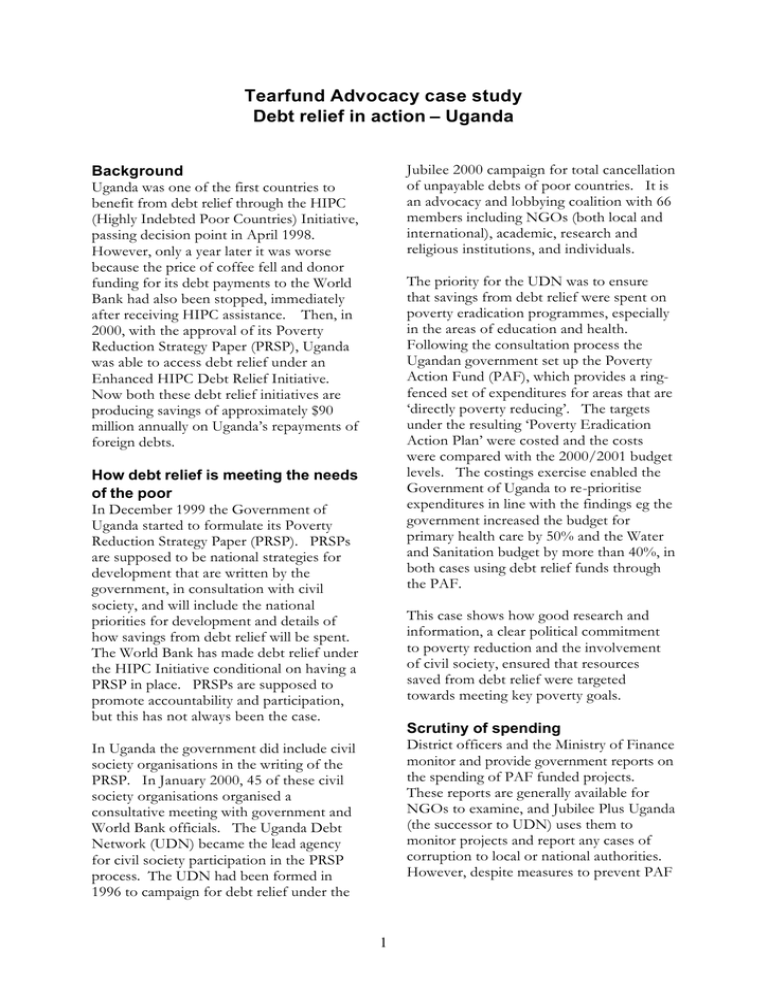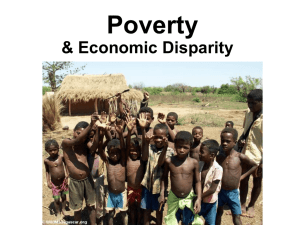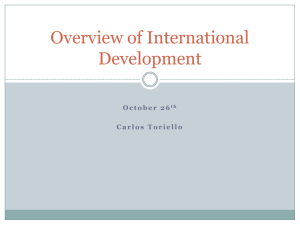Tearfund Advocacy case study Debt relief in action – Uganda
advertisement

Tearfund Advocacy case study Debt relief in action – Uganda Jubilee 2000 campaign for total cancellation of unpayable debts of poor countries. It is an advocacy and lobbying coalition with 66 members including NGOs (both local and international), academic, research and religious institutions, and individuals. Background Uganda was one of the first countries to benefit from debt relief through the HIPC (Highly Indebted Poor Countries) Initiative, passing decision point in April 1998. However, only a year later it was worse because the price of coffee fell and donor funding for its debt payments to the World Bank had also been stopped, immediately after receiving HIPC assistance. Then, in 2000, with the approval of its Poverty Reduction Strategy Paper (PRSP), Uganda was able to access debt relief under an Enhanced HIPC Debt Relief Initiative. Now both these debt relief initiatives are producing savings of approximately $90 million annually on Uganda’s repayments of foreign debts. The priority for the UDN was to ensure that savings from debt relief were spent on poverty eradication programmes, especially in the areas of education and health. Following the consultation process the Ugandan government set up the Poverty Action Fund (PAF), which provides a ringfenced set of expenditures for areas that are ‘directly poverty reducing’. The targets under the resulting ‘Poverty Eradication Action Plan’ were costed and the costs were compared with the 2000/2001 budget levels. The costings exercise enabled the Government of Uganda to re-prioritise expenditures in line with the findings eg the government increased the budget for primary health care by 50% and the Water and Sanitation budget by more than 40%, in both cases using debt relief funds through the PAF. How debt relief is meeting the needs of the poor In December 1999 the Government of Uganda started to formulate its Poverty Reduction Strategy Paper (PRSP). PRSPs are supposed to be national strategies for development that are written by the government, in consultation with civil society, and will include the national priorities for development and details of how savings from debt relief will be spent. The World Bank has made debt relief under the HIPC Initiative conditional on having a PRSP in place. PRSPs are supposed to promote accountability and participation, but this has not always been the case. This case shows how good research and information, a clear political commitment to poverty reduction and the involvement of civil society, ensured that resources saved from debt relief were targeted towards meeting key poverty goals. Scrutiny of spending District officers and the Ministry of Finance monitor and provide government reports on the spending of PAF funded projects. These reports are generally available for NGOs to examine, and Jubilee Plus Uganda (the successor to UDN) uses them to monitor projects and report any cases of corruption to local or national authorities. However, despite measures to prevent PAF In Uganda the government did include civil society organisations in the writing of the PRSP. In January 2000, 45 of these civil society organisations organised a consultative meeting with government and World Bank officials. The Uganda Debt Network (UDN) became the lead agency for civil society participation in the PRSP process. The UDN had been formed in 1996 to campaign for debt relief under the 1 money getting into corrupt hands, cases of corruption do exist. community had already had their local spring protected but when a storm swept the spring protection away they were left with a water source that was easily contaminated. Thanks to debt relief the Ugandan government funded the Kigeze Diocese programme to cover and protect their spring, making the water supply safe and reliable. Using local materials and help from community members the spring is now open again for all the community to use and own, which means they will have a guaranteed safe water supply for between 10-20 years. Jubilee Plus Uganda has been working on anti-corruption since it started and there is now a national annual anti-corruption week, which was started in 1999. They have recently launched a petition for a Recovery Fund to ensure recovery of the stolen and lost public funds and assets from the corrupt officials. The fund is also designed to re-allocate the saved money to hunger stricken districts to ensure food security first and basic social service delivery to the least developed districts. As part of this anti-corruption work Jubilee Plus is setting up local anti-poverty groups in 11 districts of Uganda. These groups aim to monitor the spending of the PAF at a local level and thereby encourage good governance. The groups will also work with the local population in raising awareness of the origins of the PAF. This is seen as a key way of ensuring the population understand their ownership of the money and take responsibility for its spending. Kigutua Primary School This government school started life under a group of trees in 1985 where 55 pupils would take shelter from the elements and attend their lessons. Later they moved into mud buildings but because the land is easily waterlogged the latrines have often swamped the area. The school now has 415 pupils, and in August 2001, thanks to the PAF money and labour provided by parents, 2 classrooms, a store and an office were built. New latrines were constructed to provide safe and clean sanitation for the whole school. Debt relief funded projects The central government of Uganda distribute the Poverty Action Fund to projects that meet the agreed targets. Bubale Health Centre The Bubale Health Centre is a governmentfunded centre serving eight parishes over an area of 40km. Before the centre was opened the local communities had to travel a further 4km to Kabale Hospital in the local town for medical treatment. Now they have a centre that provides health advice and treatment, and in January 2002 a new maternity wing was opened. In southwest Uganda the district council around the town of Kabale is running a number of PAF financed projects. Ranging from the distribution of piglets and seeds to the building of classrooms and the provision of desks for classrooms, as well as the purchase of hospital beds and bicycle ambulances. The projects usually fund the private sector to do the work. In February 2002 Stidia Tushemereirwe, 8 months pregnant, walked the 5km from her home for an antenatal check up at the new wing. Stidia who already has 4 children, and has lost 3 at child birth, used to travel to Kabale Hospital a further 4km away for care, and was forced to give birth at home. Now, thanks to money freed by debt relief, she can visit the new clinic for all her antenatal needs and will be able to give Kigeze Diocese Water and Sanitation Programme Tearfund partner the Kigeze Diocese Water and Sanitation Programme, was given PAF funding to protect 88 springs that provided clean water for communities in the diocese. In January 2002 the Kihanga community benefited from one such project. The 2 birth to her new child in the new 8-bed maternity ward. Uganda to service its debts because export earnings contribute greatly to its debt repayments. Progress so far is helping Uganda to deal with this current problem but it is a tough climb. The centre also has a full time nurse and 2 nurse assistants providing health care and basic treatment. The nurses commonly treat pneumonia, malaria and wounds and, since 2000 they are now able to prescribe drugs free of charge to anyone and have a plentiful supply of the most needed drugs. Uganda, however, is fortunate. It is only one of four countries that have so far completed the Enhanced HIPC Debt Relief Initiative. Many countries are still paying more in debt repayments than they do on education and health services. These countries need to be able to follow Uganda’s example too. The IMF and World Bank need to go further in delivering debt relief, and the G8 countries to do more to allow this to happen. The debt crisis hasn’t gone away. Nyamiyaga Primary School Nyamiyaga Primary School sits on a hill about 2km from the nearest road. While the school started as a church school it has since become a government-run school and has over 360 pupils. There should be over 400 pupils but the numbers are down due to winds and rains that completely destroyed two classrooms and an office in 2001. This forced the school to close its P7 (final year class) and use the local church as classrooms for two classes. In early 2002 funding from the PAF meant that two new classrooms could be built and new desks made. Key advocacy learning points - Public scrutiny in holding the government to account - Positive proposals for spending the money - Building local capacity to monitor progress and decide priorities - Good research - Build national coalition - Links to international campaign Another problem facing the school is that, due to its remote location, it has no water supply. Everyday pupils are sent to collect water from a tap, if it is working, or from the open stream near the main road 2 km away. Pupils, therefore, miss out on classes and suffer from tiredness. However, in January 2002 the school had a 10,000 litre water tank installed that provides enough water for the school on the premises. The problem isn’t solved as many pupils still have to fetch water before or after school, but the school has made progress. Matt Freer, April 2002 matt.freer@tearfund.org The future Even for Uganda, which is often held up as the success story of Enhanced HIPC Debt Relief Initiative, there is more to be done. Following the 11 September attacks and subsequent economic decline Uganda has seen its earnings from coffee, its major export, drop sharply by over 50% from $0.49 to $0.20. This makes is harder for 3








